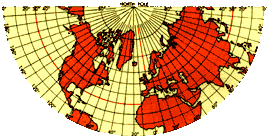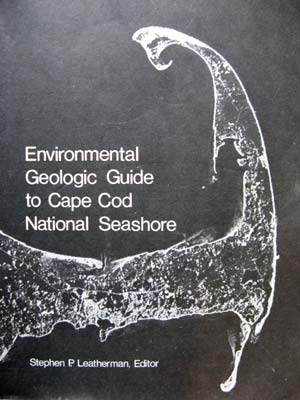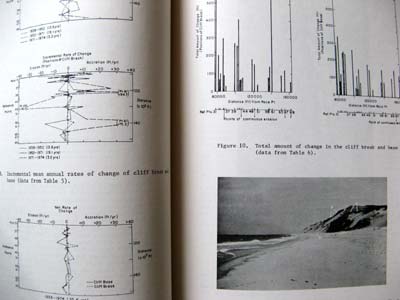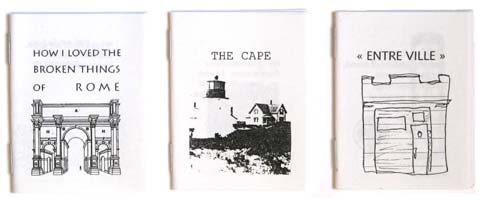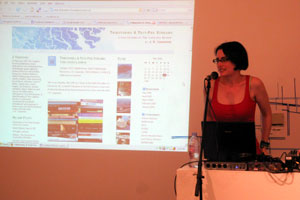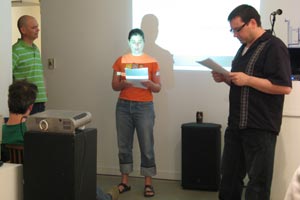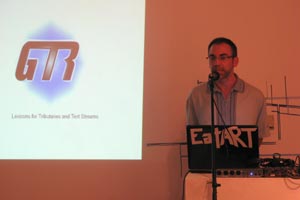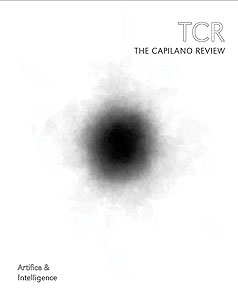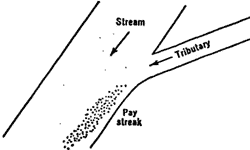Here are my responses to the questions posed by the English 214 Question Collective after their class discussion of my guest blogger post, THE CAPE: THE BACK STORY, on CultureNet @ CapilanoU on Friday, October 10, 2008:
English 214 Question Collective: As you stated in your “Back Story” guest blog, physical photographs possess a certain authority. As the transformative process of selecting a medium for publication moves “The Cape” from print-text to hypertext, does the message/meaning of your story change?
J.R. Carpenter: Yes. In every retelling, every story changes slightly. In oral story telling, it is the storyteller who wilfully alters and hones her details and delivery based on the immediacy of audience response. I came to writing through spoken word and performance. I still struggle with the finality of print publication. Once something is published in print it is fixed in time, and, like a physical photograph, cannot easily be altered. I’m not saying that’s a bad thing – I’m saying I struggle with it. The web is infinitely more fluid, flexible, updateable, and alterable. I’m not saying that’s a good thing – I’m saying that I’m more comfortable with publishing when I know I have the possibility of adjusting any part of the text, images or code in response to audience reaction. These slight editorial changes do not always change the message or meaning of they story, but they can influence the reader response in subtle ways.
The real question is: Is the print iteration of “The Cape” different from the hypertext iteration, and how? As I wrote in “The Cape: The Back-Story,” I spent a long time trying to expand “The Cape” into a “real” short story. It was hard for me to believe that a story could be so short. In print, the story passes by very quickly. An attentive reader will realize this, slow down, and take the time to fill in the blanks.
In the web iteration of “The Cape” there are only ever one, two, or three sentences on a page. The white space around the sentences, the entrespace created between the text and the images, the meta information to be read in the images (including additional text, in some of the diagrammatic images), the pause created by duration of the moving images, and the time lapse between clicking from one page to the next – all these hypertext elements serve to expand the terrain of story. On the other hand, given the visual-centric tendencies of the general web-viewing audience, the visual elements could potentially overshadow the text. Some may read the sentences as merely captions.
My favourite iteration of the “The Cape” is the mini-book version. In this small (approx 2 x 2.75inches), inexpensively reproduced, intimate format, the images and the text carry equal weight, being so close in size. The act of turning the page after every sentence adds time and reflective space to the story. And the miniature scale of the book refers subtly to childhood and the children’s book. It is my dream to publish a children’s book iteration of “The Cape” one day.
English 214 Question Collective: You mentioned that the Geological Guide photographs interest you more than your own family history. Do you find using fact with fiction allowed you to create a more authentic story?
J.R. Carpenter: Yes. True and false are binaries, opposites. Fiction both contains and confounds the either/or of truth and falsehood. This, to me, is more representational of real life than any idealized notion of either historical accuracy or pure fantasy. “The Cape” addresses certain presuppositions – that we all have fond childhood memories of our grandmothers, that little girls want certain things and behave in certain ways, and that Cape Cod is a lovely place to visit – by conflating observations to the contrary of those statements with other irrefutable facts: I never learned to Whistle. I wish I’d asked my uncle to teach me how to spit instead. The Cape, as Cape Cod is often called, is, as you may know, a narrow spit of land.
Writing a first-person child narrator is always tricky. No one takes a serious kid seriously. Arming the child narrator of “The Cape” with facts and charts and maps was the least I could do for her. Not that it does her much good. That no one is listening to her is what makes it an authentic story. The older we get, the more we convince ourselves that our memories are true. Why do we trust our own memories of childhood, yet doubt the perceptions of children? These are questions best left to fiction.
“Life as described in fiction … is never just life as it was lived by those who imagined, wrote, read, or experienced it but rather the fictional equivalent, what they were obliged to fabricate because they weren’t able to live it in reality and, as a result, resigned themselves to live only in the indirect and subjective way it could be lived: in dreams and in fiction. Fiction is a lie covering up a deep truth: it is life as it wasn’t, life as the men and women of a certain age wanted to live it and didn’t and thus had to invent.”
Mario Vargas Llosa, Letters to a Young Novelist, trans. Natasha Wimmer, NY: Picador, 2002, page 8.
English 214 Question Collective: As the work is entitled “The Cape”, the importance of place and memory – as you imply – are highlighted by the imagery in the erosion of the Maritime shorelines and how memories dissipate. This seems to create a strong sense of sublimity within your work. Is this something you have reflected on?
J.R. Carpenter: Yes. Notions of place have long pervaded my fiction writing and electronic literature works. In my web-based work the images of place are literally images. Maps figure prominently – operating, often simultaneously as images, interface, metaphors for place, and stand-ins for non-existent family photographs. My parents were immigrants. I grew up in a different country than everyone I was related to. We moved around a lot when I was a kid. I think my early adoption of the internet was due in part to my attraction to it as a placeless place. Many of my works may be read as web “sites” of longing for belonging, for home.
The sense of sublimity you mention emerges most strongly when I am writing about long-ago places, and pasts that could never be mine. I barely knew my grandmother Carpenter and can lay no ancestral claim to being “from” Cape Cod. I don’t even know if she was from there. Maybe she just retired to there. Somehow, historical aerial photographs of the coastal erosion of the Cape Cod National Seashore seemed to be the perfect, most sublime representation of this elusive, tenuous, quasi-fictional relationship.
For another example, take a look at one of my earliest works of electronic literature: Mythologies of Landforms and Little Girls [1996]. Mythologies is a non-linear narrative about a first crush as experienced by two children left to their own devices while the grown-ups are presumably busy elsewhere. A map of Nova Scotia operates as the interface and central image of the piece. I used geological images and terminology to further distance myself from rural Nova Scotia, and childhood in general. In this case, plate tectonic theory seemed to best represent the cataclysmic, renting split between the end of childhood obliviousness and the beginning of adult knowing.
At fault, as it were, seemed to be the sea,
always the sea, putting another meter between
Africa and the Americas every hundred years,
pushing Europe further and further away from
the Canadian Maritimes, in dutiful geology.
I will also suggest, for a print example of the evocation of the sublime through intertwined images of memory and place in my fiction, the very short story Precipice [2003]:
A habitual stomach-sleeper, she dreams of falling. Face down, the falling is more like flying; she never hits the ground. Often in her dreams of falling there is a precipice: a clearly defined line before which, perhaps for acres on end, grow grassy, sloping fields of thistle, pock-marked by dry caked dung. And after? Arriving at the precipice all fields and fences end abruptly and fall away. Forty feet below, there lies a beach of stones; a vague sense of bottom. And beyond: an inordinate amount of ocean.
In closing, let me thank you once again for your close reading of “The Cape” and you’re your thoughtful questions. It has been a pleasure. Very best, from Montreal,
J.R. Carpenter || Luckysoap & Co.
. . . . .
